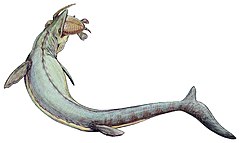Mozazaur
| Mosasaurus | |||
| Conybeare, 1822[1] | |||

| |||
| Systematyka | |||
| Domena | |||
|---|---|---|---|
| Królestwo | |||
| Typ | |||
| Podtyp | |||
| Gromada | |||
| Podgromada | |||
| Nadrząd | |||
| Rząd | |||
| Rodzina | |||
| Rodzaj |
mozazaur | ||
| Typ nomenklatoryczny | |||
|
Mosasaurus hoffmanni Mantell, 1829 | |||
| Gatunki | |||
|
| |||
Mozazaur (Mosasaurus) – rodzaj wymarłych jaszczurek morskich z rodziny mozazaurów (Mosasauridae); jego nazwa oznacza „jaszczur znad Mozy”[2] (łac. Mosa „Moza”; gr. σαυρος sauros „jaszczurka”). Była to jedna z największych jaszczurek w dziejach.
Mosasaurus żył w okresie późnej kredy (mastrycht, około 71–66 mln lat temu) na terenach obecnych: Europy (Belgia, Holandia, Szwecja, Polska), Ameryki Północnej (USA; stany Dakota Południowa i New Jersey), Afryki, Nowej Zelandii i być może Japonii. Jego szczątki po raz pierwszy znaleziono w okolicach miasta Maastricht w Holandii w 1780. Był jednym z najpóźniejszych, najbardziej zaawansowanych ewolucyjnie i największych przedstawicieli Mosasauridae; Mosasaurus hoffmanni – największy znany gatunek rodzaju – mógł osiągać ponad 17,5 m długości[3] (u okazu z Penzy sama czaszka mierzyła prawdopodobnie ponad 1,7 m[4]). Czaszka M. hoffmanni była najmniej kinetyczna spośród Mosasauridae. Prawdopodobnie M. hoffmanni był zwierzęciem pływającym przy powierzchni, na co wskazują dość duże oczodoły i słabo wykształcone narządy węchu, przypuszczalnie w dość głębokich wodach przybrzeżnych[3]. W miejscu żołądka u jednego z okazów M. missouriensis odnaleziono kości ryby skrzelokształtnej[5].
Bell (1997) uważa rodzaj Mosasaurus za parafiletyczny[6].
Przypisy
[edytuj | edytuj kod]- ↑ W.D. Conybeare: Fossil Crocodiles and other Saurian Animals. W: J. Parkinson: Outlines of oryctology. An introduction to the study of fossil organic remains; especially those found in the British strata: intended to aid the student in his inquiries respecting the nature of fossils, and their connection with the formation of the earth. London: M.A. Nattali, 1822, s. 298. (ang.).
- ↑ 19 Facts About Mosasaurus [online], worldecologyfoundation.com [zarchiwizowane z adresu 2022-09-24].
- ↑ a b Theagarten Lingham-Soliar. Anatomy and functional morphology of the largest marine reptile known, Mosasaurus hoffmanni (Mosasauridae, Reptilia) from the Upper Cretaceous, Upper Maastrichtian of The Netherlands. „Philosophical Transactions of the Royal Society B”. 347, s. 155–180, 1995. DOI: 10.1098/rstb.1995.0019. (ang.).
- ↑ D. V. Grigoriev. Giant Mosasaurus hoffmanni (Squamata, Mosasauridae) from the Late Cretaceous (Maastrichtian) of Penza, Russia. „Proceedings of the Zoological Institute RAS”. 318 (2), s. 148–167, 2013. (ang.).
- ↑ Takuya Konishi, Michael G. Newbrey, Michael W. Caldwell. A small, exquisitely preserved specimen of Mosasaurus missouriensis (Squamata, Mosasauridae) from the upper Campanian of the Bearpaw Formation, western Canada, and the first stomach contents for the genus. „Journal of Vertebrate Paleontology”. 34 (4), s. 802–819, 2014. DOI: 10.1080/02724634.2014.838573. (ang.).
- ↑ G. L. Bell: A phylogenetic revision of North American and Adriatic Mosasauroidea. W: J. M. Callaway, E. L. Nicholls (red.): Ancient Marine Reptiles. San Diego: Academic Press, 1997, s. 293–332.
Linki zewnętrzne
[edytuj | edytuj kod]- Mozazaur na oceansofkansas.com (ang.)
- Budowa czaszki mozazaura (ang.)
Text is available under the CC BY-SA 4.0 license; additional terms may apply.
Images, videos and audio are available under their respective licenses.
